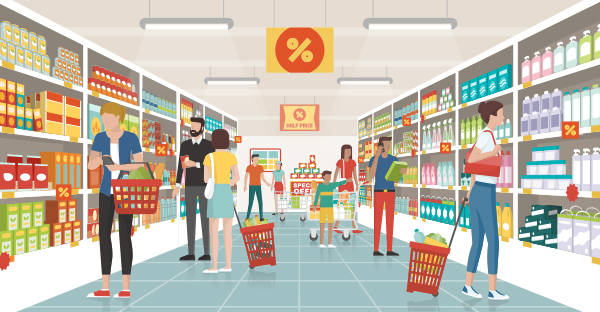Amazon Bites Into The Grocery Sector With Whole Foods Buyout

As of August 28th, 2017, the news that’s set the eCommerce and grocery sectors on fire will become official:
Amazon will have completed its buyout of brick and mortar grocery retailer, Whole Foods.
Quoting directly from Amazon’s PR team:
Amazon and Whole Foods Market today announced that Amazon’s acquisition of Whole Foods Market will close on Monday, August 28, 2017, and the two companies will together pursue the vision of making Whole Foods Market’s high-quality, natural and organic food affordable for everyone. As a down payment on that vision, Whole Foods Market will offer lower prices starting Monday on a selection of best-selling grocery staples across its stores, with more to come.
In addition, Amazon and Whole Foods Market technology teams will begin to integrate Amazon Prime into the Whole Foods Market point-of-sale system, and when this work is complete, Prime members will receive special savings and in-store benefits. The two companies will invent in additional areas over time, including in merchandising and logistics, to enable lower prices for Whole Foods Market customers.
What does this mean for Amazon eCommmerce shoppers? Will they be able to conveniently purchase most (if not all) of their favorite shelf-stable products? Will Amazon enable a way for shoppers to gain access to delicate and refrigerated products?
Consumer will certainly wonder if Whole Foods locations are closing in their neighborhoods. They’ll wonder if they’ll be able to gain access to the same types of high-quality, organic products. In particular, they’ll wonder if they’ll still be able to gain convenient access to the same types of foods and beverages that are manufactured with their special dietary needs in mind.
While many of these questions (and more) will be answered in the months to come, here’s what we know for sure:
Amazon Prime subscribers will benefit heartily from the acquisition
According to Business Insider, current Amazon Prime subscribers (and future subscribers) are going to find immediate benefits from this acquisition. In short, Prime members will be able to score deep discounts on products, in addition to the price slashing that’s already been promised.
…The two companies will together pursue the vision of making Whole Foods Market’s high-quality, natural and organic food affordable for everyone. As a down payment on that vision, Whole Foods Market will offer lower prices starting Monday on a selection of best-selling grocery staples across its stores, with more to come.
In addition, Amazon and Whole Foods Market technology teams will begin to integrate Amazon Prime into the Whole Foods Market point-of-sale system, and when this work is complete, Prime members will receive special savings and in-store benefits. The two companies will invent in additional areas over time, including in merchandising and logistics, to enable lower prices for Whole Foods Market customers.
Customers will enjoy lower prices on products like Whole Trade bananas, organic avocados, organic large brown eggs, organic responsibly-farmed salmon and tilapia, organic baby kale and baby lettuce, animal-welfare-rated 85% lean ground beef, creamy and crunchy almond butter, organic Gala and Fuji apples, organic rotisserie chicken, 365 Everyday Value organic butter, and much more
And the Washington Post (Owned by Amazon’s CEO, Jeff Bezos) reports:
Amazon said it will continue to lower prices at Whole Food stores and will eventually offer special discounts and in-store benefits to Amazon Prime members.
Will the promise of high-quality food become reality?
While the logistics of the acquisition are still in their infancy, here’s what’s being reported on what shoppers can expect regarding food quality.
Jeff Wilke, chief executive of Amazon Worldwide Consumer, said in a statement:
Everybody should be able to eat Whole Foods Market quality — we will lower prices without compromising Whole Foods Market’s long-held commitment to the highest standards…
…There is significant work and opportunity ahead, and we’re thrilled to get started.
Are the price slashes going to cheapen the Whole Foods brand?
Beyond worrying about the availability of the types of foods that Whole Foods loyalists have come to expect and rely upon, many will worry about their overall shopping experience, now that Amazon is taking over.
Whole Foods shoppers have come to expect top-notch, white glove treatment from all touchpoints of their shopping experience, and they’d certainly be concerned about losing all that’s come to identify the Whole Foods brand.
But financial analysts are the first to predict that by lowering prices, Whole Foods will actually gain the ability to strengthen its brand:
Analysts said the slashing of prices was an obvious move. Whole Foods — nicknamed “whole paycheck” in some circles — has long struggled to shed its reputation as a pricey alternative to other supermarket chains. The company’s prices are about 15 percent higher than at the average grocery store, according to Morgan Stanley. By immediately cutting prices, analysts say Amazon is sending a clear signal that sweeping changes are in store, even if it means temporarily cutting into profit margins.
In other words, the priority is being placed on the needs of the consumer, even if catering to customers means losing out on immediate profits.
And for the record, not only will Whole Foods retain its retail locations, but it will continue to be headquartered out of Austin, Texas, with its current CEO and co-founder (John Mackey) remaining at the helm.
Tagged acquisition, Amazon, Amazon acquisition, Amazon Prime, eCommerce, Whole Foods, Whole Foods acquisition





